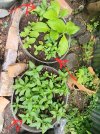@synthzizer This is what i got on a reverse google image search.
View attachment 89896
Blumea balsamifera - Ngai Camphor Plant Sambong, Nat, Kukundara
Polska wersja

PLANT PROFILE
Blumea balsamifera is a perennial, robust bush that grows naturally in whole Southeast Asia. It is also often cultivated for both homeuse and on commercial scale, as it is commonly used as a herbal medicine. It have a very long traditions of use in medicinal systems of China, Vietnam, Thailand, India, Indonesia, The Philippines and other tropical and subtropical countries of that region. It have many health benefits and is famous for being good source of essential oil rich in borneol - compound that is similar but superior to camphor. That oil obtained from Blumea Balsamifera (by steam distillation) is called Ngai Camphor and is said to have better properties than Camphor oil obtained from Cinnamomum camphora and so its price is usually higher. But it is not rated as high as Camphor oil from Dryobalanops spp.The leaves of B. balsamifera are noted in Neatherlandish Pharmacopaeia, Pharmacopeia of India and Chinese Materia Medica, it is used both in Ayurveda and Unani.
There are several species of Blumea that have recorded medicinal use like Blumea lacera, Blumea axillaris, Blumea lanceolaria, Blumea laciniata, Blumea densiflora and it is all used in the same way as Blumea balsamifera, which is the most robust and aromatic from Blumea species. Before this plant was called Blumea balsamifera it was already known as Conyza balsamifera, it also have other synonyms like Pluchea balsamifera, Baccharis salvia, Blumea grandis, Conyza appendiculata to name just few, but all those names are now out of use.
Here are some of the most common names of Blumea balsamifera used in different countries, regions and languges: Ngai Camphor Plant, Nagi Camphor, Blumea Camphor, Camphor Plant (English), Camphrier (France), Poung-ma-theing, Phone-ma-thien, Hpone-mathein (Myanmar), Bai Mat (Cambodia), Cai dai be (Vietnam), Nat (Laos), Nat-yai (Thailand), Ai na xiang, Pen tsao (China), Chapa, Bonga Chapa (Malay), Kukundara, Kukkuradru, Kukudru, Gangaapatri (in Ayurveda, Sanskrit), Kakarondaa (in Unani medicine system), Kukronda, Kakoranda (Hindi), Bhambuda, Bhamaruda (Marathi), Kukur-soka, Kuk-sungh (Bengali), Mugongre (Assam), Sembung Utan (Sundanese), Sembung Gatnung (Javanese), Sembung, Capa (Indonesian), Sambong (Tagalog), Lakadbulan (Bikol), Alibon (Visayan), Sobsob (Ilokano).







